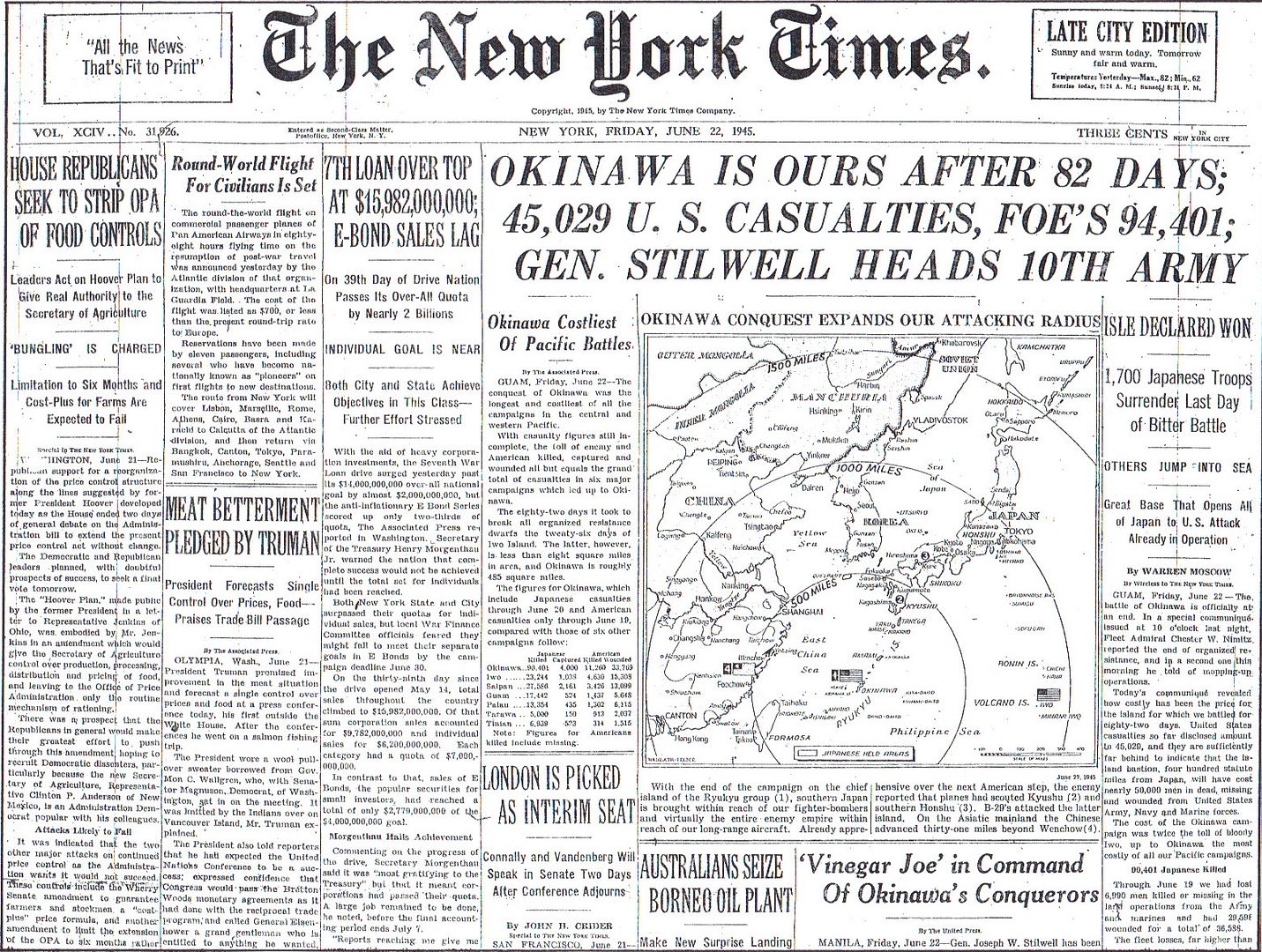
Posted on 06/22/2015 5:16:44 AM PDT by Homer_J_Simpson

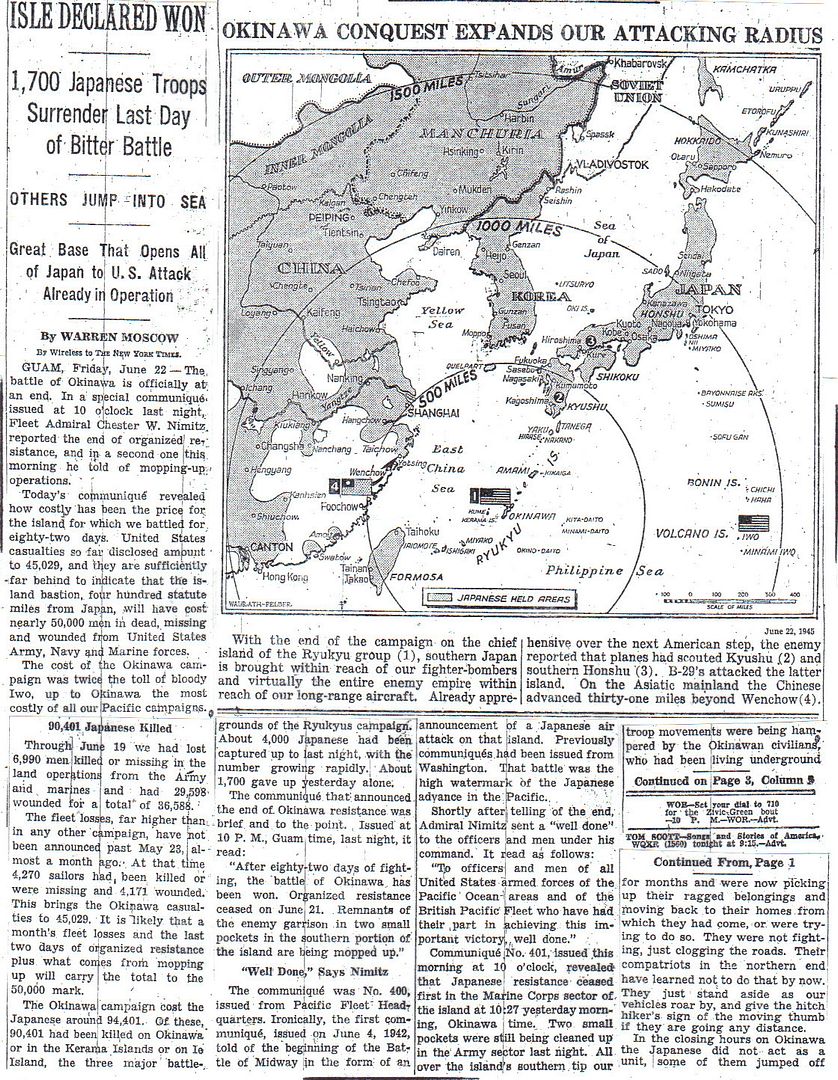
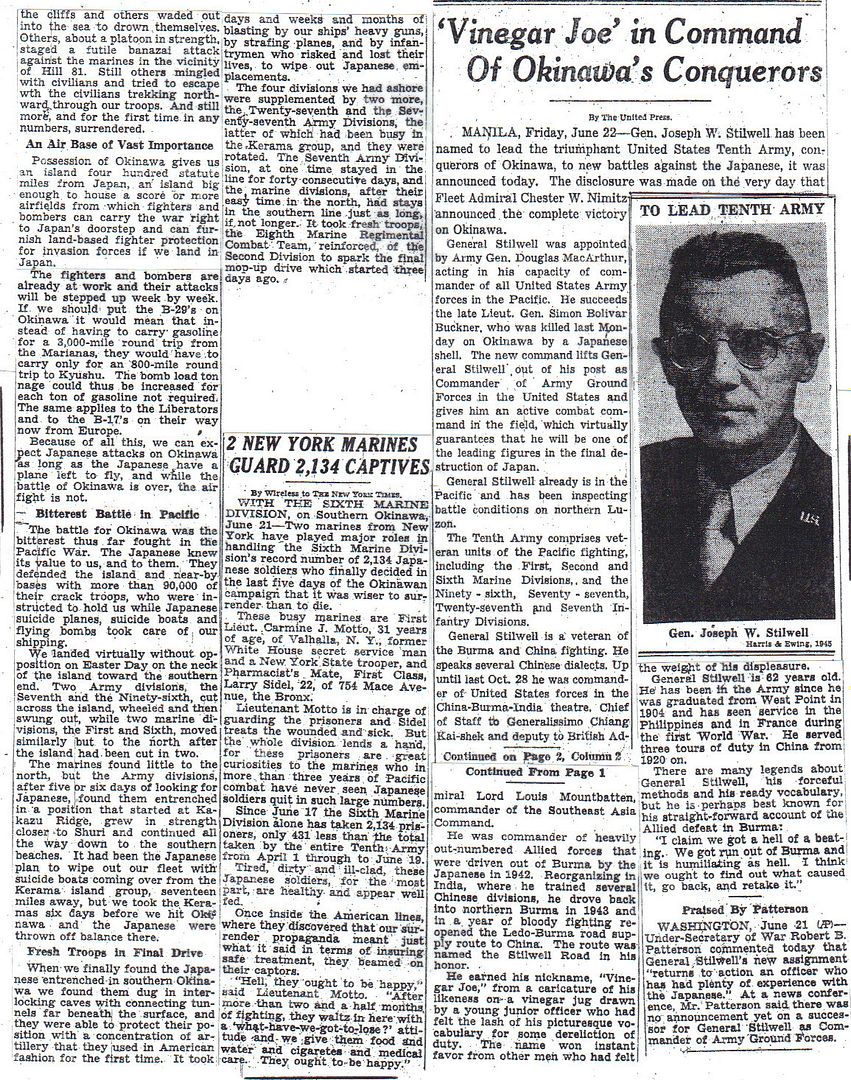
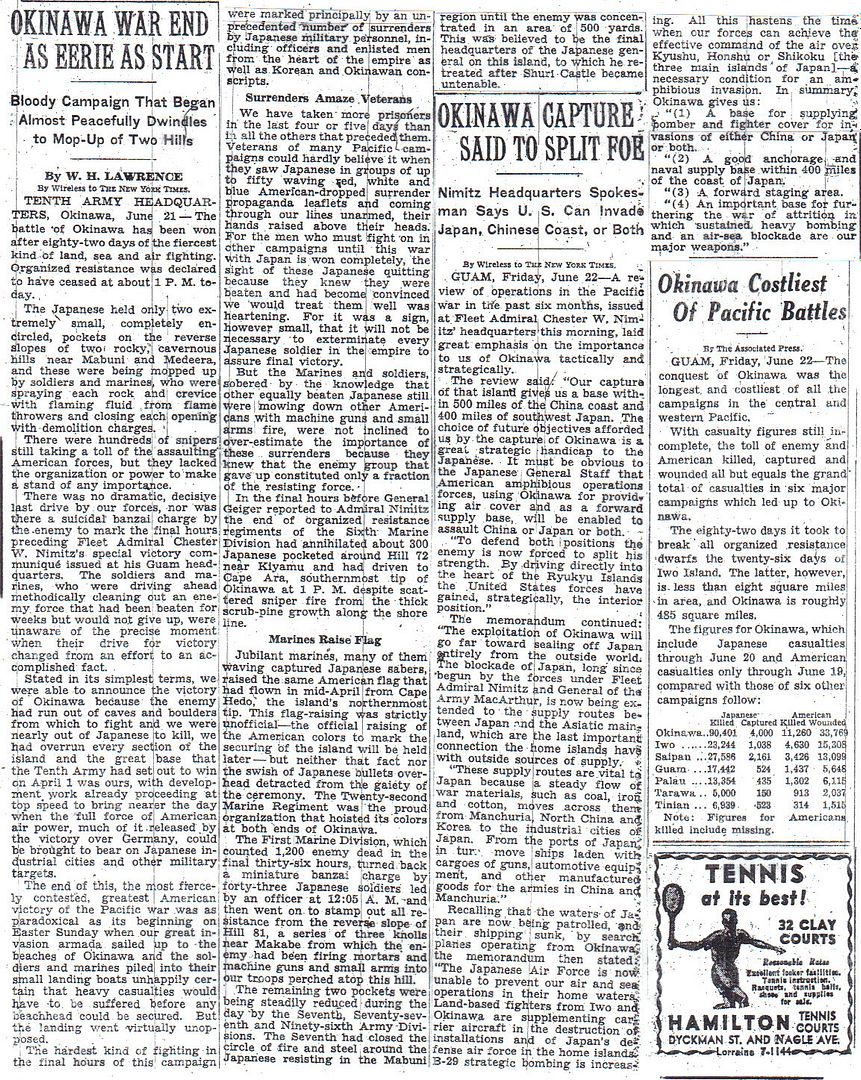
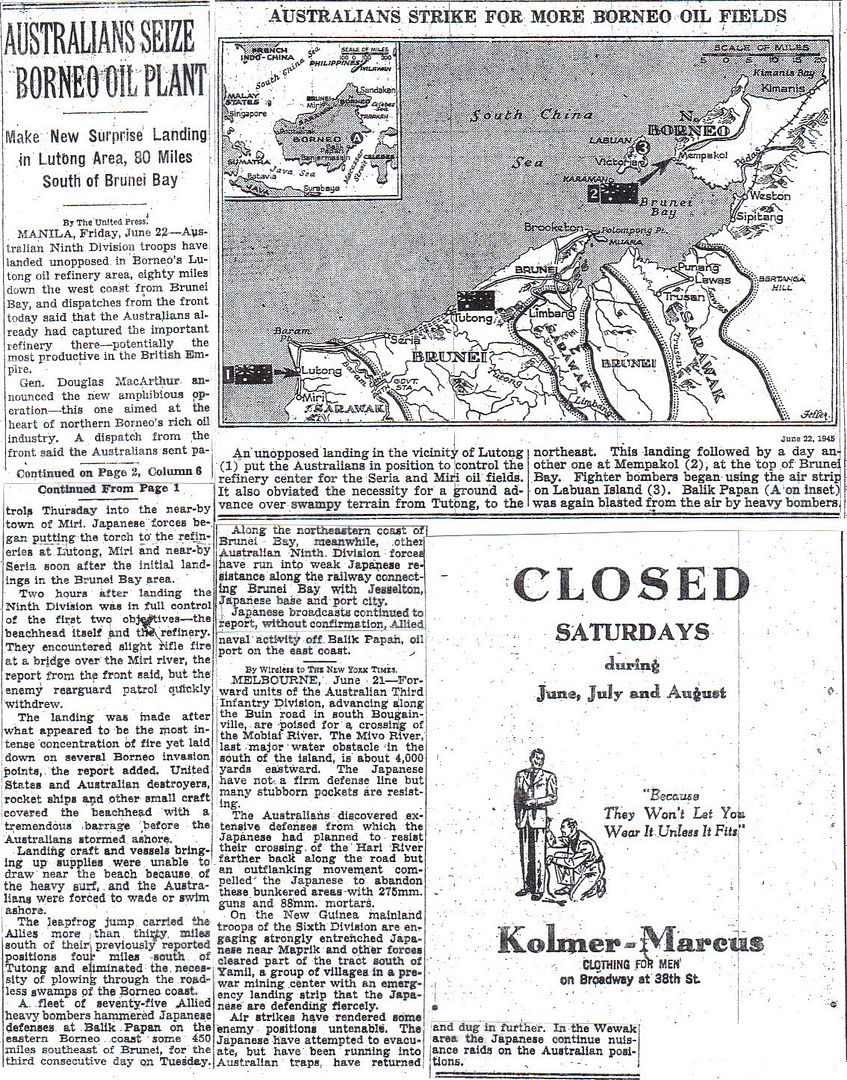
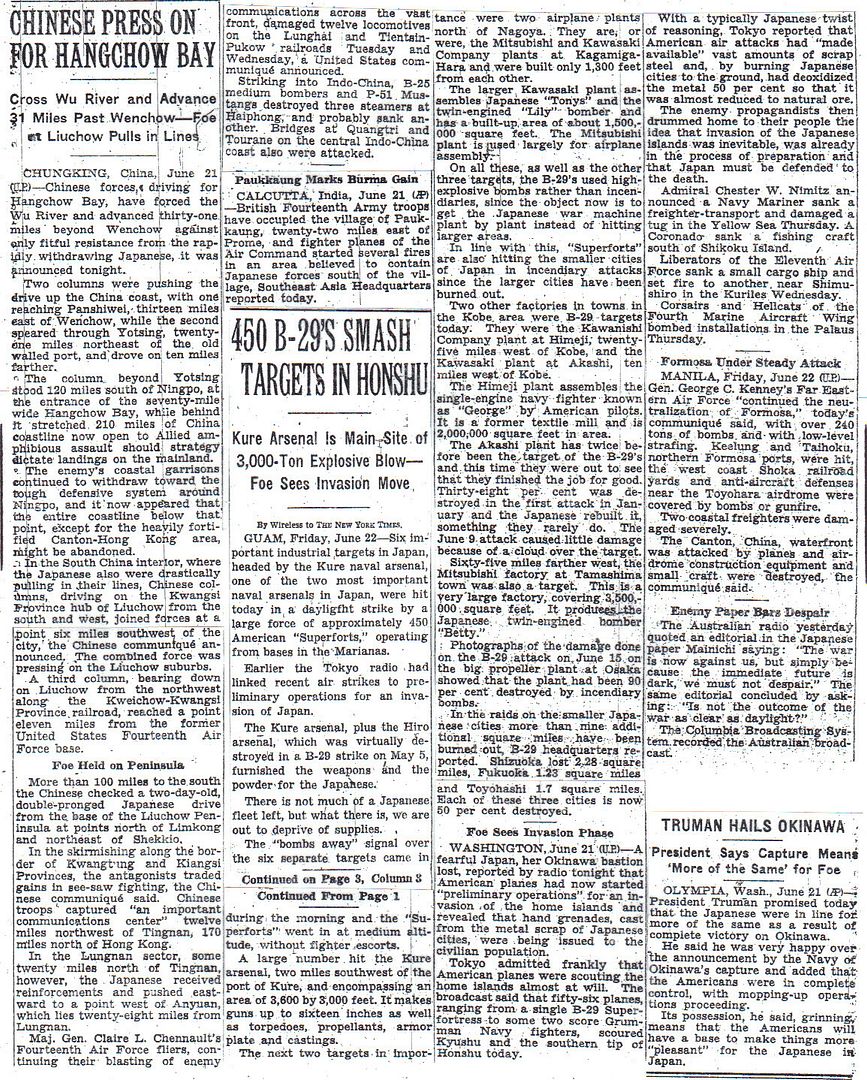
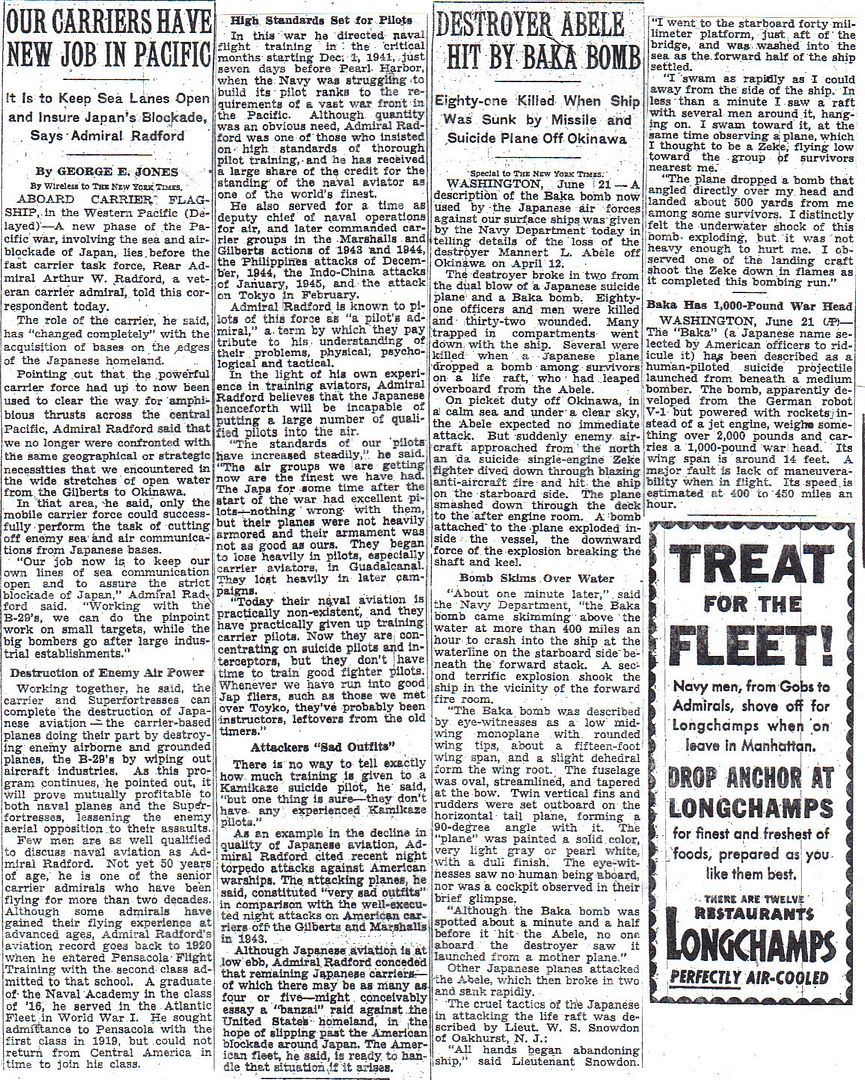
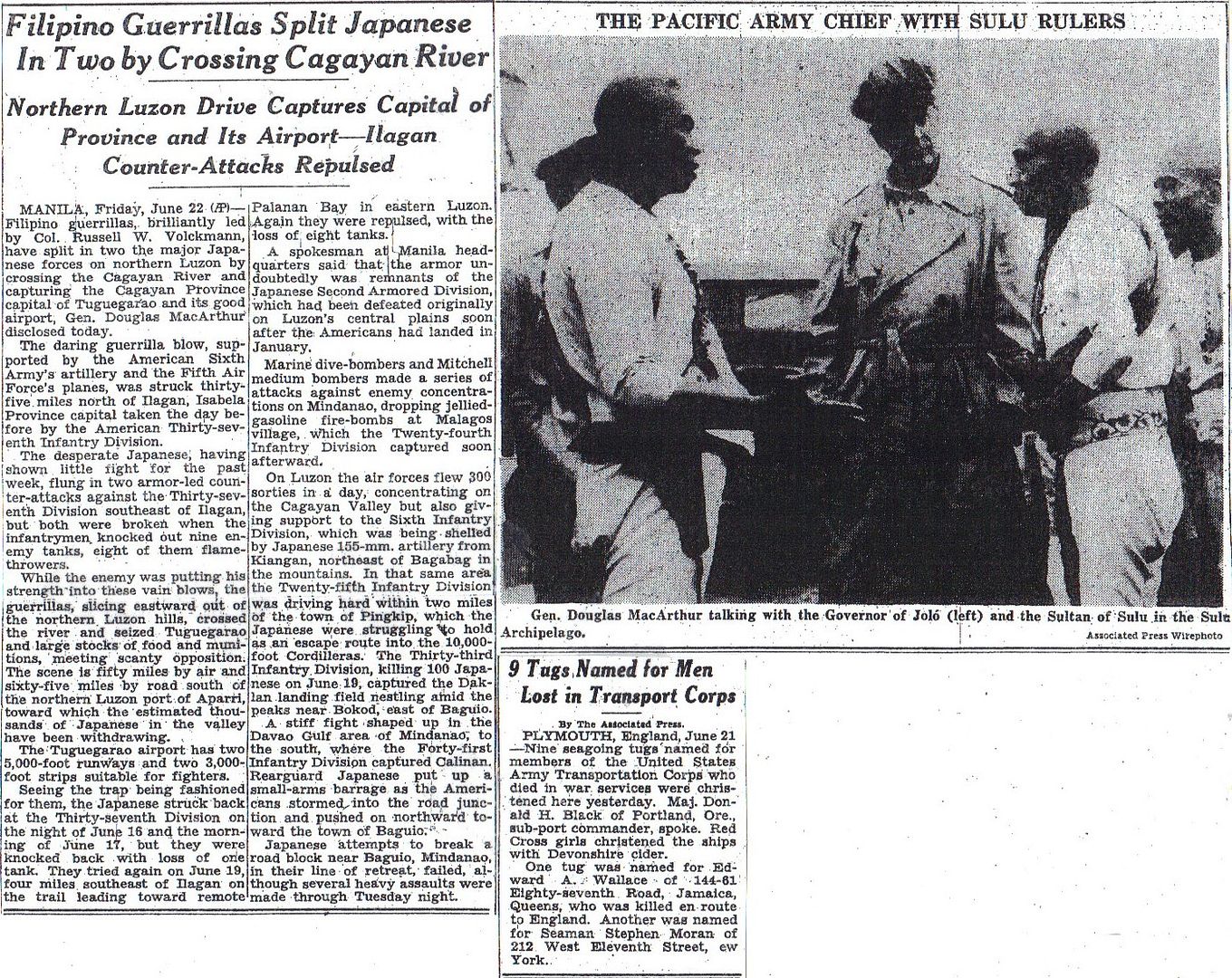
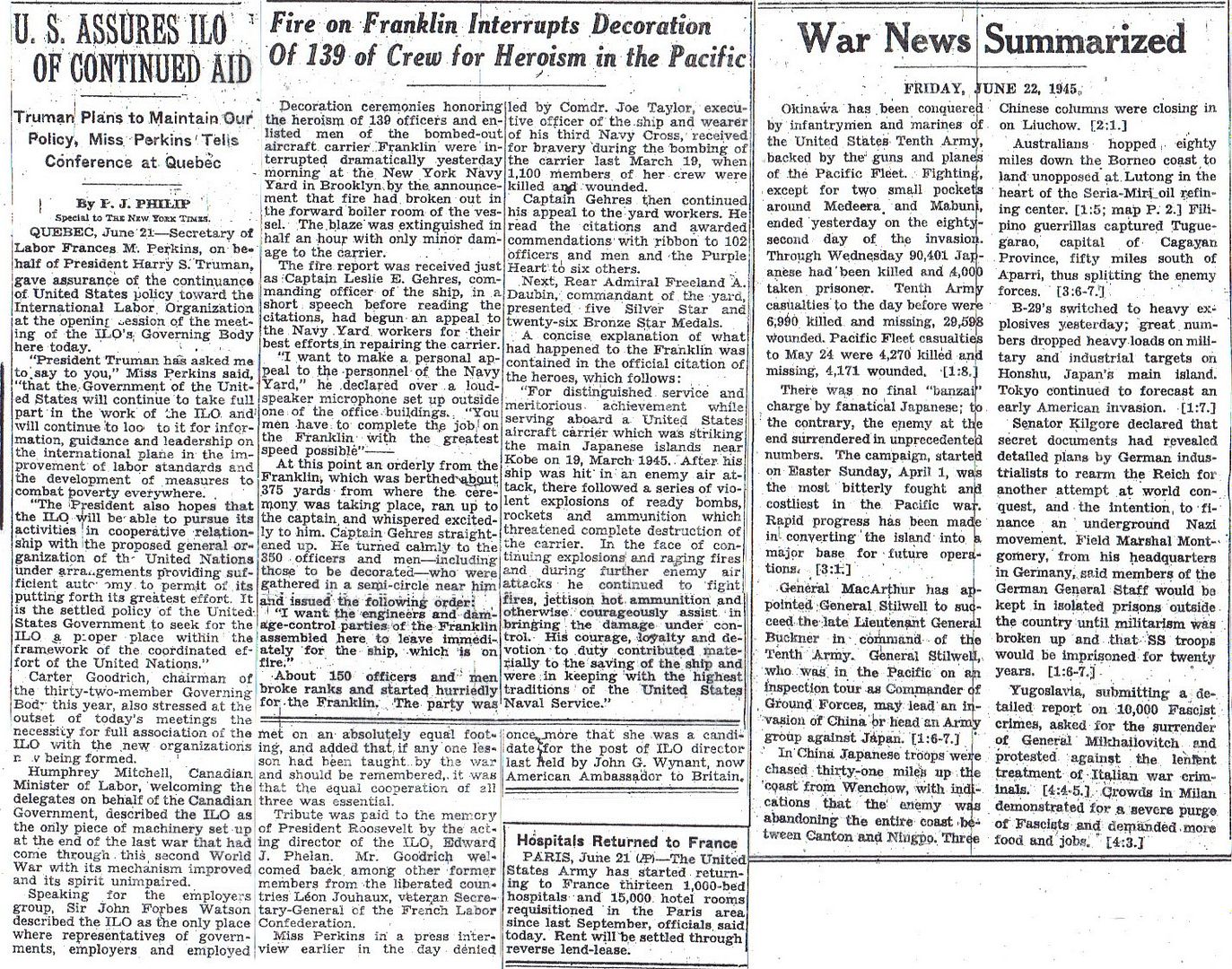

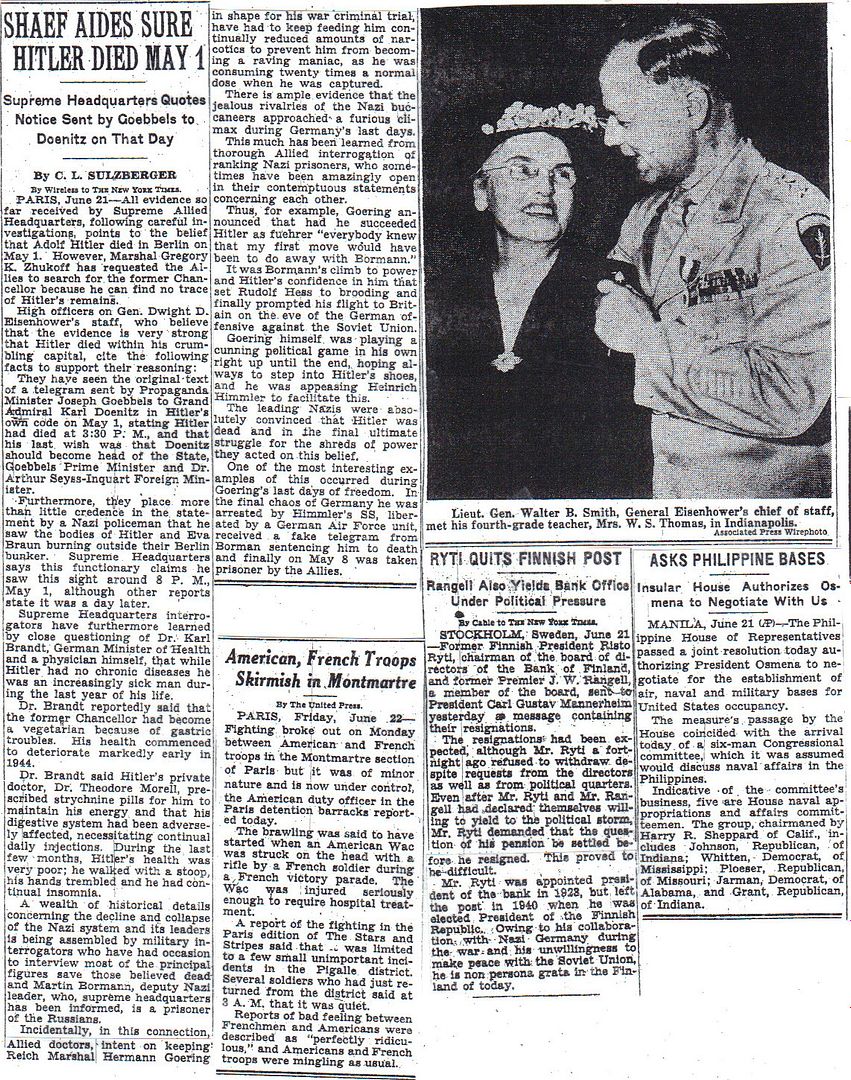
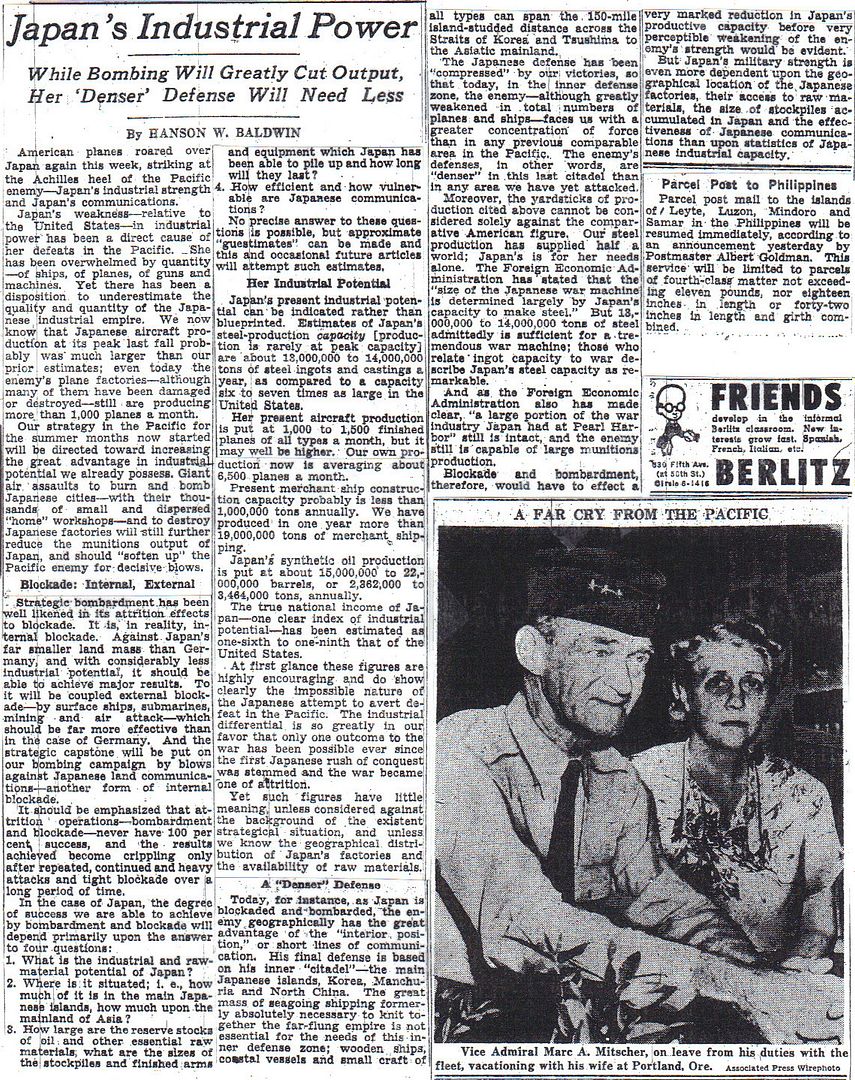
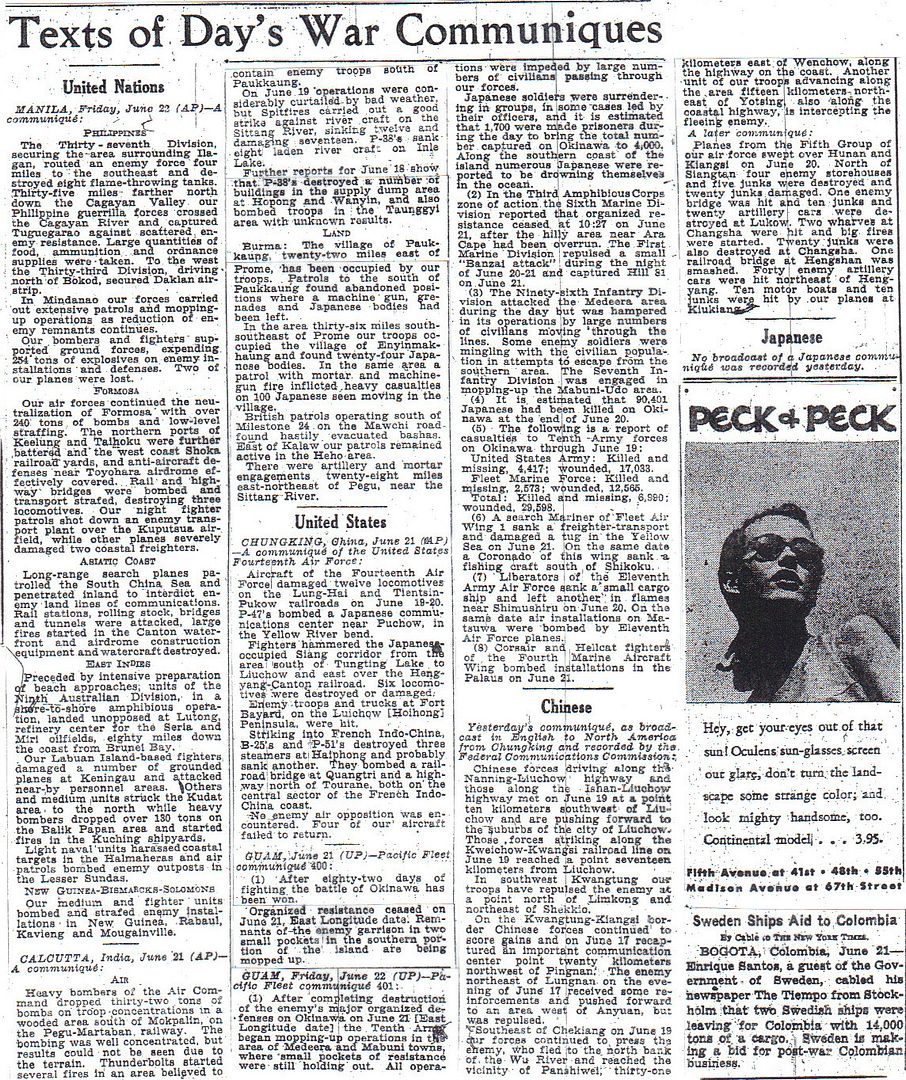
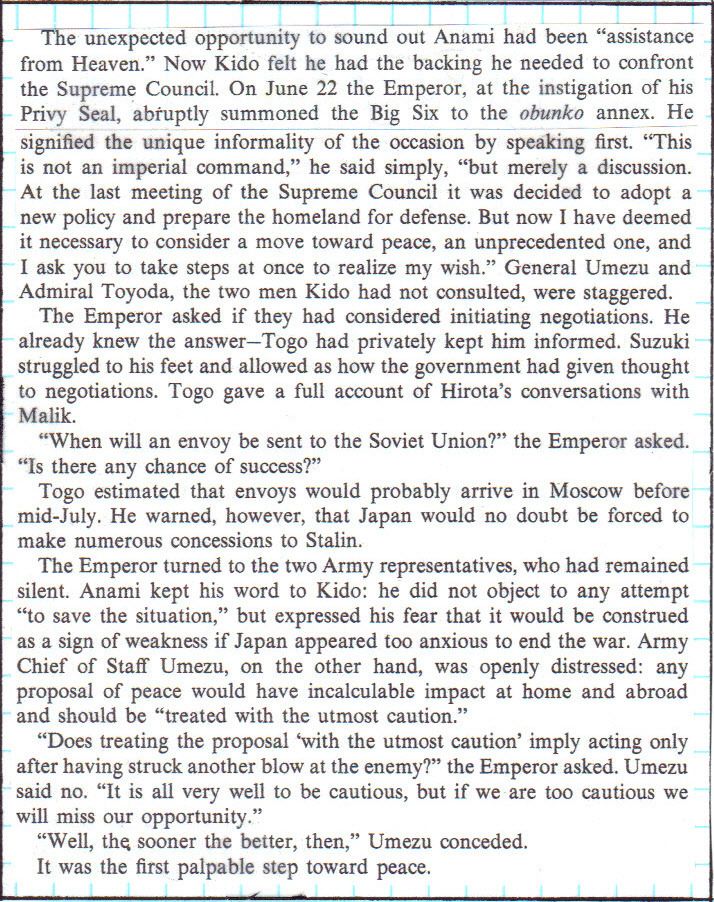
John Toland, The Rising Sun: The Decline and Fall of the Japanese Empire, 1936-1945
http://www.etherit.co.uk/month/5/22.htm
June 22nd, 1945 (FRIDAY)
UNITED KINGDOM: Destroyer HMS Finisterre launched.
FRANCE: General Joseph Stilwell assumes command of the US Tenth Army, succeeding Buckner who was killed on Okinawa. (Marc James Small)
CHINA: Japanese troops quit Liuchow, setting it on fire before the advancing Chinese.
JAPAN: Okinawa: : The fighting on Okinawa ends. 12,500 US soldiers and Marines are dead. They also show 35,500 wounded. The US navy shows 36 ships sunk with 368 damaged. 763 US aircraft are lost. The Japanese show 120,000 military and 42,000 civilians dead. The US count is 7,830 aircraft and numerous naval vessels, including the battleship Yamato. There are also 10,755 Japanese prisoners taken. This is the first battle in which significant Japanese prisoners are taken.
:The Japanese Supreme Council for the Direction of the War, is requested by the Emperor to end the war. The SCDW is known as the Big 6 of the Japanese Cabinet. PM, FM, War Minister, Navy Minister, Army CofS, Navy CofS.
The submarine USS Barb (SS-220) surfaces off Hokkaido Island, Japan and fires twelve 5-inch (127 mm) rockets with 9.6-pound (4.4 kg) warheads at the town of Shari. This is the first ballistic missile launch by a U.S. submarine.
The USAAF’s XXI Bomber Command in the Marianas dispatches 446 B-29s on six missions against targets on South Honshu Island, Japan during the day.
Mission 215: 162 B-29s attack the Kure Naval Arsenal and 12 others hit alternate targets; 72% of the roof area of the arsenal is damaged, the incomplete submarines I-204 and I-352 are destroyed and the escort destroyer HIJMS Nire and the submarine HIJMS RO 67 are damaged. Two B-29s are lost.
Mission 216: 108 B-29s hit the Mitsubishi aircraft plant at Tamashima destroying 135 of 231 machine tools and almost half the roof area; 10 others hit alternate targets; 2 B-29s are lost.
Mission 217: 52 B-29s attack the Kawanishi aircraft plant at Himeji causing great destruction among the buildings and total destruction of machine tools; 4 others hit alternate targets.
Missions 218 and 219: 34 B-29s hit the Mitsubishi and Kawasaki aircraft plants at Kagamigahara and 10 others hit alternate targets; 1 B-29 is lost.
Mission 220: 25 B-29s hit the Kawasaki aircraft factory at Akashi and 1 hits an alternate target.
Consolidated PB4Y-2s of the USN’s Patrol Bombing Squadron One Hundred Eighteen (VPB-118) based at Yonton Airfield, Okinawa continues aerial mining of the waters off Korea.
FORMOSA: One of two B-32s bomb an alcohol plant at Heito, Formosa with 500 pound (227 kg) bombs but the second one misses flak positions with 260-pound (118 kg) frag bombs.
BORNEO: Japanese resistance on Tarakan island comes to an end.
CANADA: Corvette HMCS Lindsay departed refit Saint John, New Brunswick for Sydney Nova Scotia.
Corvette HMCS Bittersweet paid off and returned to RN at Aberdeen, Scotland
Corvettes HMCS Brandon and Sorel paid off Sorel, Province of Quebec.
U.S.A.:
Destroyer USS O’Hare launched.
Submarine USS Menhaden commissioned.
Eighty-two days to capture Okinawa. Let’s put that into perspective regarding other large battles fought in the European Theater. The Battle of the Bulge, the largest and costliest land battle fought by the United States Army, is considered to have lasted from December 16, 1944 to January 25, 1945, or 41 days. The Normandy Campaign lasted from D-Day on June 6, 1944 until the destruction of the last organized resistance in the Falaise Pocket on August 21, 1944, or 77 days.
The Battle for Okinawa was longer, but not the longest land battle fought by the United States Army. That honor probably goes to the operations clearing the Island of Luzon, which started January 09, 1945, and is still grinding on, or to the operations along the Gustav Line in Italy from mid-November 1943 to early June 1944.
God bless the memory of all of those who fought to conquer Okinawa.
The casualty figures are staggering.
But even more staggering is the contrast between American casualties and Japanese casualties. Not only were ours half of the enemy’s, ours were heavily weighted to the wounded, while almost all of theirs were made up of the dead. Ninety thousand. My God.
The Japs really did believe that such iron will was unconquerable. And against just about anyone but the Americans, they probably would have been correct.
One of the most amazing clashes of iron wills in history.
But our iron was stronger than their iron. And there was a lot more of it.
Good point. One thing I've been considering reading these articles is, knowing the American Way of War places so much emphasis on artillery firepower, just how much ordinance did we expend in those 82 days?
Keep in mind that every Japanese target on Okinawa was within reach of naval artillery. For shore bombardment, nothing on land can match the power of battleship or cruiser guns. The most common heavy artillery is the 155mm, and medium artillery was the 105mm gun. A battalion of such guns was three batteries of four guns, or 12 guns to a battalion. A 105mm gun translates to roughly four inches, while 155mm is roughly a six-inch gun.
So a battalion of 105mm guns = 12 four inch guns, which is less firepower than three destroyers, each with four or five 5" guns. A 155mm battalion is roughly equivalent to a light cruiser. And one advanage the ships have over the land batteries is their mobility, and most importantly, their rate of fire. A ship is not just the guns, but all of the complex shell storage and ammunition hoists to feed those guns from the shell rooms. That firing system yields a rate of fire that cannot be duplicated on land.
Add to it the fact that NOTHING on land could duplicate the nine to twelve 12" to 16" guns of an American battleship. Not in terms of gun size, range, accuracy, concentration and rate of fire.
For those 82 days, the fleet stood off Okinawa pounding away. I wonder the tonnage of steel and high explosive rained down on Okinawa.
This is all I could find in the brief time I have this morning:
“By the time the battle for the Ryukyu Islands ended American forces had expended 97,800 tons of ammunition, most of that tonnage in artillery. Indeed taking into account the size of the invading force, the length of the fighting front, and the duration of the campaign, the invading force’s concentration of naval, air, and ground fire unmatched in the history of warfare.”
http://www.history.army.mil/brochures/ryukyus/ryukyus.htm
More than two Iowa class battleships.
Yesterday's thread included a comment by someone visiting years later who reported the ground completely covered by shrapnel.
It's interesting that in the Philippine valleys where there are no mountains or jungles the Japanese defense is far less effective.
The pictures of the happy homecomings are really great to see!
One big difference between the Philippines and Okinawa. In Okinawa, the Japanese didn’t have to watch their backs.
Disclaimer: Opinions posted on Free Republic are those of the individual posters and do not necessarily represent the opinion of Free Republic or its management. All materials posted herein are protected by copyright law and the exemption for fair use of copyrighted works.